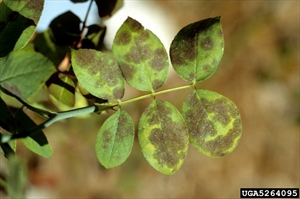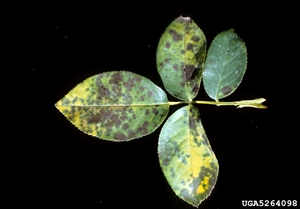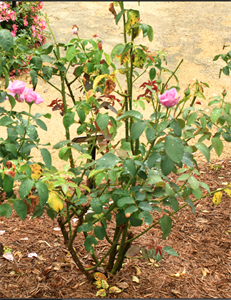- Worldwide distribution. In Oceania, Australia, Fiji, New Caledonia, New Zealand, Papua New Guinea. A fungal leaf spot of rose.
- Damage: irregular black spots on the leaves with irregular borders, sometimes with yellow halos, causing leaves to yellow and fall. Spots on young stems. Overtime, defoliation leads to weak plants and fewer flowers.
- Spread: as spores in wind-blow rain and rain-splash. Survival on fallen leaves or on leaves, bud scales and stems on the plant.
- Cultural control: in the nursery - check plants for infection; in the field/garden choose sunny, well-drained site, and space to allow good air circulation; collect and burn fallen leaves, and apply mulch; water frequently, early morning, avoiding overhead irrigation; prune regularly to aid air movement; apply fertilizer little and often; weed; resistant varieties - but if growing susceptible types, mix with those resistant.
- Chemical control: minerals (i) sulphur, copper, sodium (or potassium) bicarbonate; botanicals (ii) neem; (iii) microbials - Bacillus subtilis; synthetics iii) protectant fungicides - captan, chlorothalonil, mancozeb or systemic fungicides - triazole or strobilurin.
Pacific Pests, Pathogens and Weeds - Online edition
Pacific Pests, Pathogens, Weeds & Pesticides
Rose black spot (388)
Black spot of rose. It is also known as leaf blotch of roses.
Diplocarpon rosae; this is the sexual name of the fungus. It is also known by its asexual state as Marssonia rosae.
AUTHOR Grahame Jackson
Information from Ned Tisserat, Colorado State University. (https://wiki.bugwood.org/HPIPM:Diplocarpon_rosae); and Wikipedia. (https://en.wikipedia.org/wiki/Diplocarpon_rosae); and from CABI (2018) Diplocarpon rosae (black spot of roses). Crop Protection Compendium. (https://www.cabi.org/cpc/datasheet/19153). Photos 1&2 Florida Division of Plant Industry, Florida Department of Agriculture and Consumer Services, Bugwood.com.
Produced with support from the Australian Centre for International Agricultural Research under project HORT/2016/18: Responding to emerging pest and disease threats to horticulture in the Pacific islands, implemented by the University of Queensland and the Pacific Community.







